Movement in Early Childhood: Impact on Learning and Development
VerifiedAdded on 2022/09/21
|6
|1499
|22
Essay
AI Summary
This essay delves into the critical role of movement in early childhood development, emphasizing its influence on a child's cognitive skills, emotional awareness, and physical abilities. It underscores the importance of educators and parents incorporating movement into learning plans to foster comprehensive development. The essay discusses how movement enhances memory, social skills, and environmental understanding, ultimately contributing to a child's active and healthy lifestyle. Personal experiences are shared to illustrate the impact of movement on language acquisition and cognitive development. The conclusion reiterates the necessity of integrating movement into early childhood education to cultivate essential life skills and promote holistic growth.
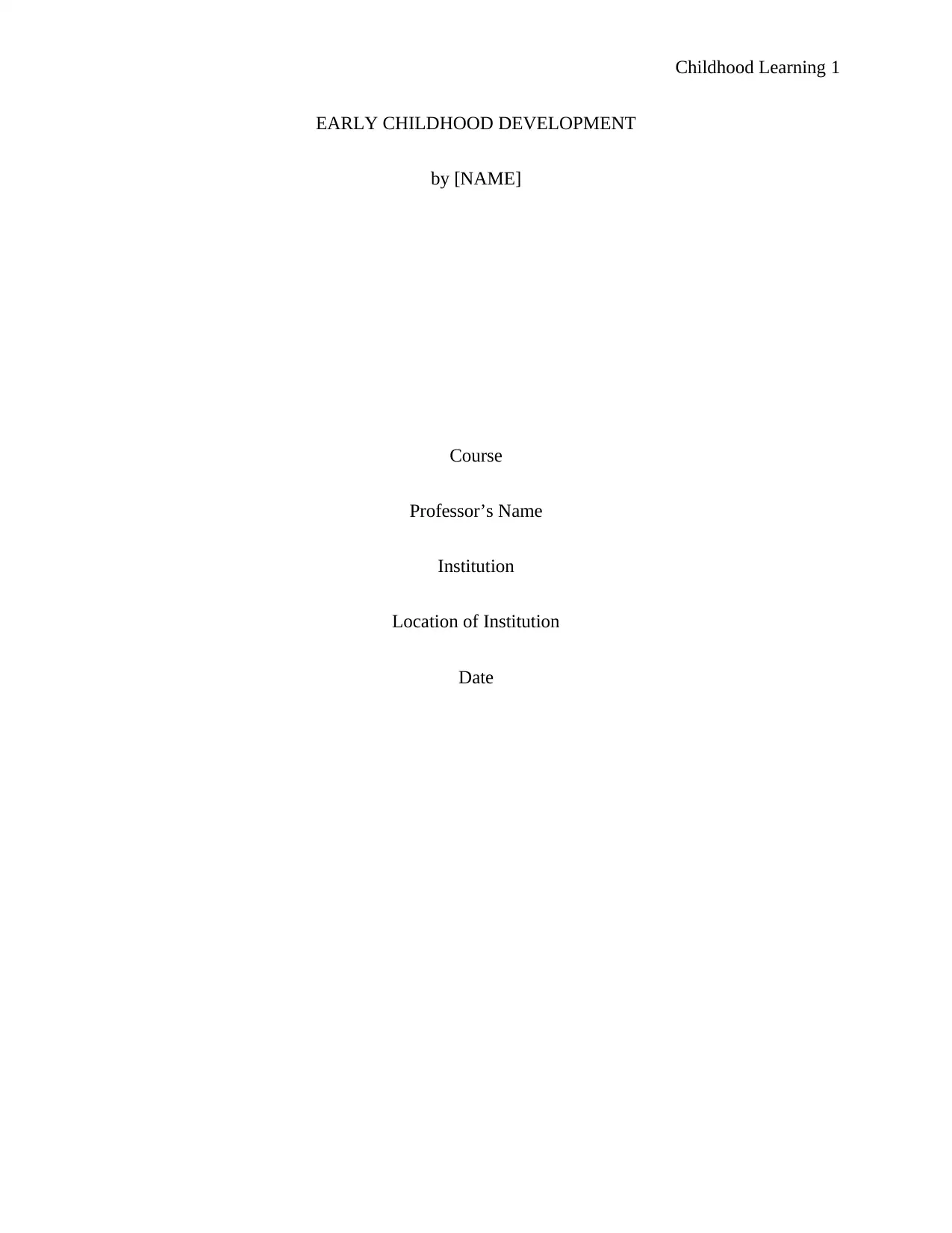
Childhood Learning 1
EARLY CHILDHOOD DEVELOPMENT
by [NAME]
Course
Professor’s Name
Institution
Location of Institution
Date
EARLY CHILDHOOD DEVELOPMENT
by [NAME]
Course
Professor’s Name
Institution
Location of Institution
Date
Paraphrase This Document
Need a fresh take? Get an instant paraphrase of this document with our AI Paraphraser
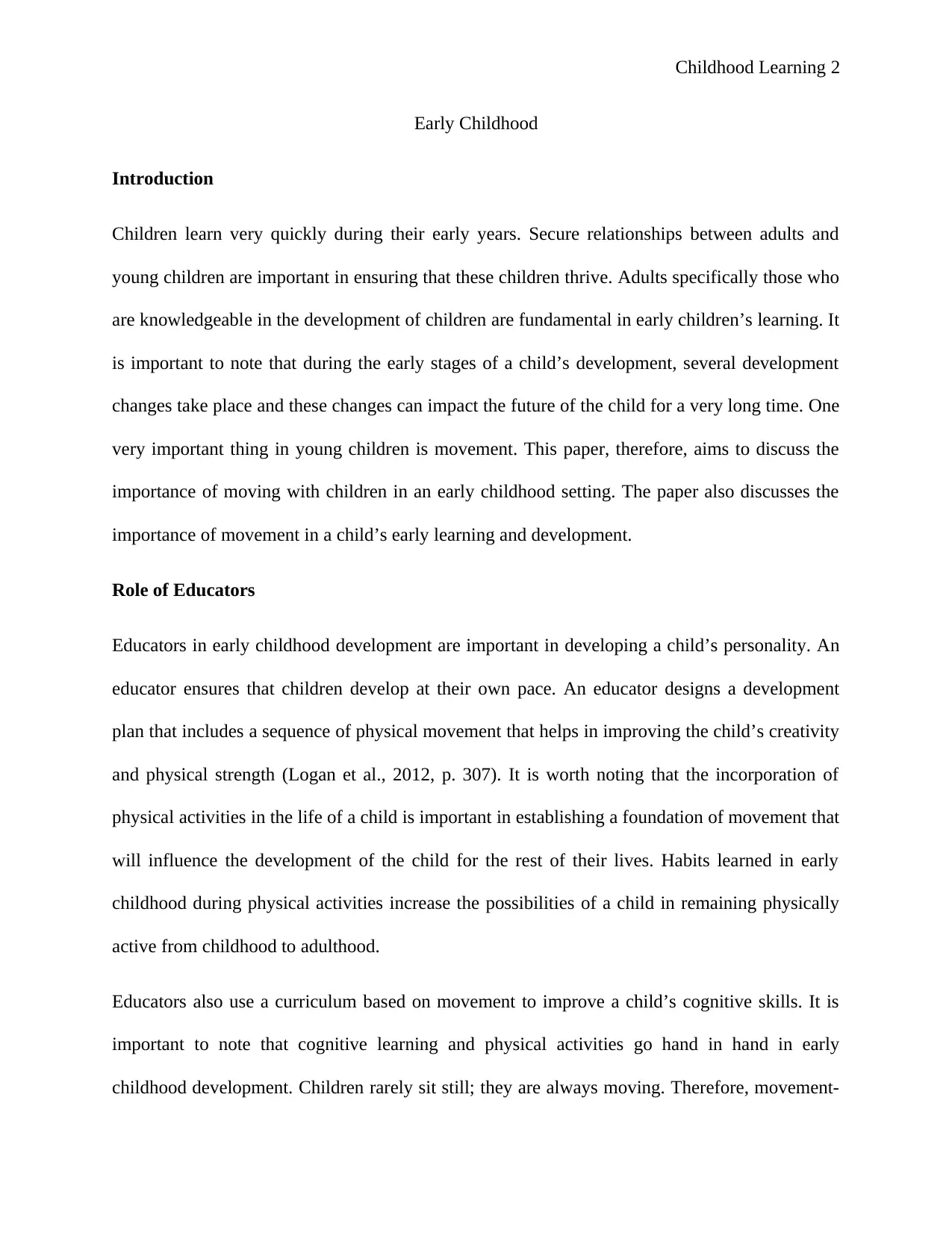
Childhood Learning 2
Early Childhood
Introduction
Children learn very quickly during their early years. Secure relationships between adults and
young children are important in ensuring that these children thrive. Adults specifically those who
are knowledgeable in the development of children are fundamental in early children’s learning. It
is important to note that during the early stages of a child’s development, several development
changes take place and these changes can impact the future of the child for a very long time. One
very important thing in young children is movement. This paper, therefore, aims to discuss the
importance of moving with children in an early childhood setting. The paper also discusses the
importance of movement in a child’s early learning and development.
Role of Educators
Educators in early childhood development are important in developing a child’s personality. An
educator ensures that children develop at their own pace. An educator designs a development
plan that includes a sequence of physical movement that helps in improving the child’s creativity
and physical strength (Logan et al., 2012, p. 307). It is worth noting that the incorporation of
physical activities in the life of a child is important in establishing a foundation of movement that
will influence the development of the child for the rest of their lives. Habits learned in early
childhood during physical activities increase the possibilities of a child in remaining physically
active from childhood to adulthood.
Educators also use a curriculum based on movement to improve a child’s cognitive skills. It is
important to note that cognitive learning and physical activities go hand in hand in early
childhood development. Children rarely sit still; they are always moving. Therefore, movement-
Early Childhood
Introduction
Children learn very quickly during their early years. Secure relationships between adults and
young children are important in ensuring that these children thrive. Adults specifically those who
are knowledgeable in the development of children are fundamental in early children’s learning. It
is important to note that during the early stages of a child’s development, several development
changes take place and these changes can impact the future of the child for a very long time. One
very important thing in young children is movement. This paper, therefore, aims to discuss the
importance of moving with children in an early childhood setting. The paper also discusses the
importance of movement in a child’s early learning and development.
Role of Educators
Educators in early childhood development are important in developing a child’s personality. An
educator ensures that children develop at their own pace. An educator designs a development
plan that includes a sequence of physical movement that helps in improving the child’s creativity
and physical strength (Logan et al., 2012, p. 307). It is worth noting that the incorporation of
physical activities in the life of a child is important in establishing a foundation of movement that
will influence the development of the child for the rest of their lives. Habits learned in early
childhood during physical activities increase the possibilities of a child in remaining physically
active from childhood to adulthood.
Educators also use a curriculum based on movement to improve a child’s cognitive skills. It is
important to note that cognitive learning and physical activities go hand in hand in early
childhood development. Children rarely sit still; they are always moving. Therefore, movement-
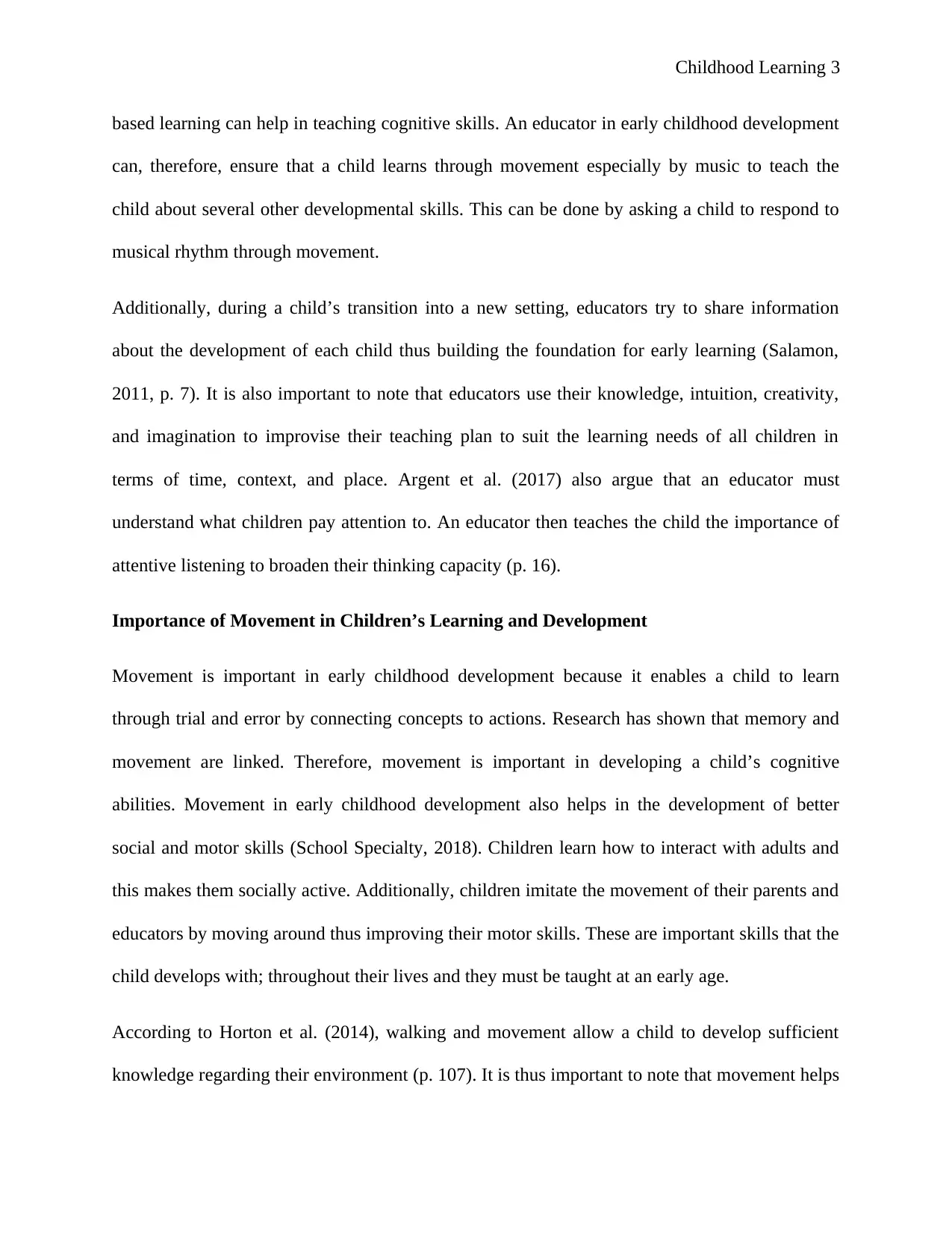
Childhood Learning 3
based learning can help in teaching cognitive skills. An educator in early childhood development
can, therefore, ensure that a child learns through movement especially by music to teach the
child about several other developmental skills. This can be done by asking a child to respond to
musical rhythm through movement.
Additionally, during a child’s transition into a new setting, educators try to share information
about the development of each child thus building the foundation for early learning (Salamon,
2011, p. 7). It is also important to note that educators use their knowledge, intuition, creativity,
and imagination to improvise their teaching plan to suit the learning needs of all children in
terms of time, context, and place. Argent et al. (2017) also argue that an educator must
understand what children pay attention to. An educator then teaches the child the importance of
attentive listening to broaden their thinking capacity (p. 16).
Importance of Movement in Children’s Learning and Development
Movement is important in early childhood development because it enables a child to learn
through trial and error by connecting concepts to actions. Research has shown that memory and
movement are linked. Therefore, movement is important in developing a child’s cognitive
abilities. Movement in early childhood development also helps in the development of better
social and motor skills (School Specialty, 2018). Children learn how to interact with adults and
this makes them socially active. Additionally, children imitate the movement of their parents and
educators by moving around thus improving their motor skills. These are important skills that the
child develops with; throughout their lives and they must be taught at an early age.
According to Horton et al. (2014), walking and movement allow a child to develop sufficient
knowledge regarding their environment (p. 107). It is thus important to note that movement helps
based learning can help in teaching cognitive skills. An educator in early childhood development
can, therefore, ensure that a child learns through movement especially by music to teach the
child about several other developmental skills. This can be done by asking a child to respond to
musical rhythm through movement.
Additionally, during a child’s transition into a new setting, educators try to share information
about the development of each child thus building the foundation for early learning (Salamon,
2011, p. 7). It is also important to note that educators use their knowledge, intuition, creativity,
and imagination to improvise their teaching plan to suit the learning needs of all children in
terms of time, context, and place. Argent et al. (2017) also argue that an educator must
understand what children pay attention to. An educator then teaches the child the importance of
attentive listening to broaden their thinking capacity (p. 16).
Importance of Movement in Children’s Learning and Development
Movement is important in early childhood development because it enables a child to learn
through trial and error by connecting concepts to actions. Research has shown that memory and
movement are linked. Therefore, movement is important in developing a child’s cognitive
abilities. Movement in early childhood development also helps in the development of better
social and motor skills (School Specialty, 2018). Children learn how to interact with adults and
this makes them socially active. Additionally, children imitate the movement of their parents and
educators by moving around thus improving their motor skills. These are important skills that the
child develops with; throughout their lives and they must be taught at an early age.
According to Horton et al. (2014), walking and movement allow a child to develop sufficient
knowledge regarding their environment (p. 107). It is thus important to note that movement helps
⊘ This is a preview!⊘
Do you want full access?
Subscribe today to unlock all pages.

Trusted by 1+ million students worldwide
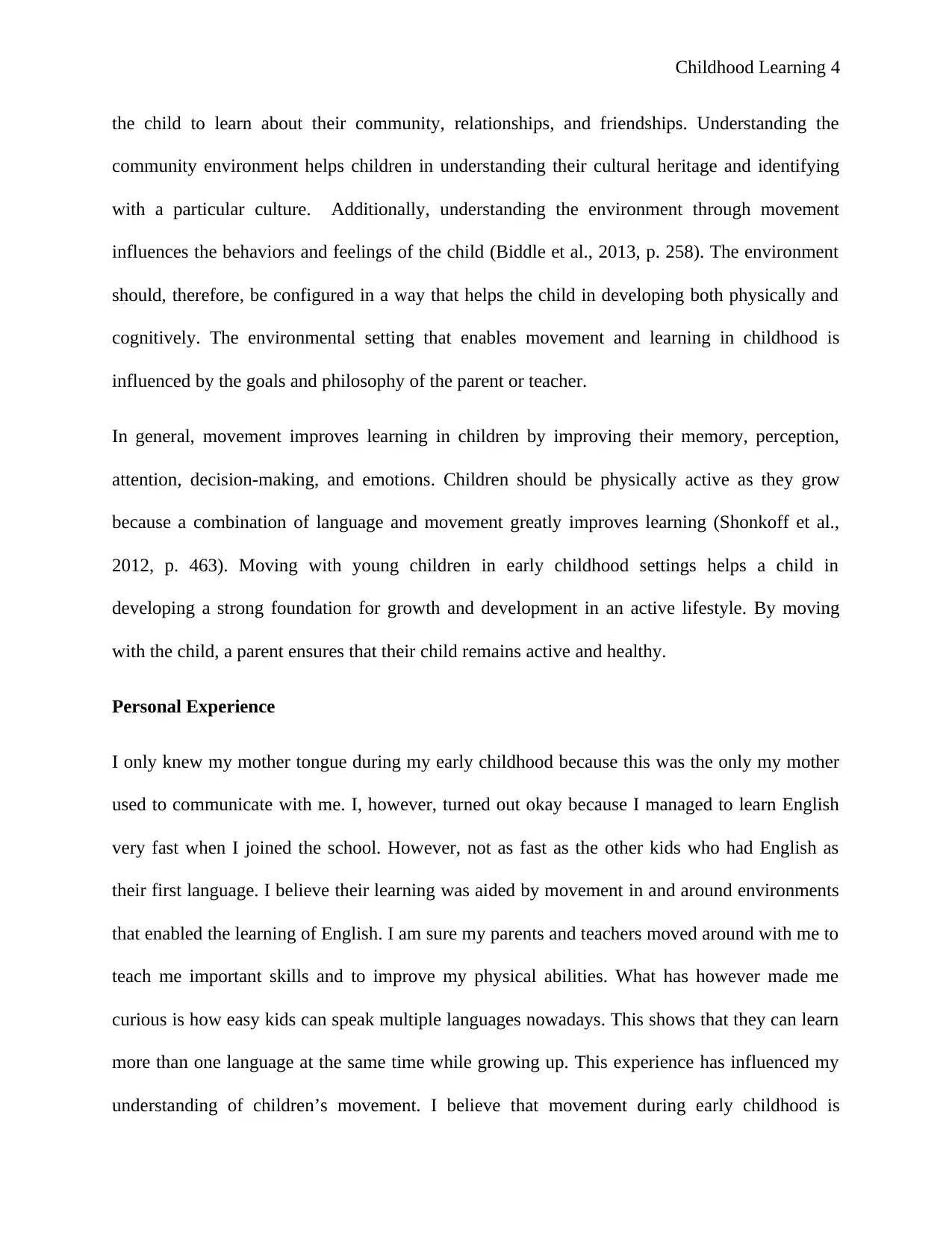
Childhood Learning 4
the child to learn about their community, relationships, and friendships. Understanding the
community environment helps children in understanding their cultural heritage and identifying
with a particular culture. Additionally, understanding the environment through movement
influences the behaviors and feelings of the child (Biddle et al., 2013, p. 258). The environment
should, therefore, be configured in a way that helps the child in developing both physically and
cognitively. The environmental setting that enables movement and learning in childhood is
influenced by the goals and philosophy of the parent or teacher.
In general, movement improves learning in children by improving their memory, perception,
attention, decision-making, and emotions. Children should be physically active as they grow
because a combination of language and movement greatly improves learning (Shonkoff et al.,
2012, p. 463). Moving with young children in early childhood settings helps a child in
developing a strong foundation for growth and development in an active lifestyle. By moving
with the child, a parent ensures that their child remains active and healthy.
Personal Experience
I only knew my mother tongue during my early childhood because this was the only my mother
used to communicate with me. I, however, turned out okay because I managed to learn English
very fast when I joined the school. However, not as fast as the other kids who had English as
their first language. I believe their learning was aided by movement in and around environments
that enabled the learning of English. I am sure my parents and teachers moved around with me to
teach me important skills and to improve my physical abilities. What has however made me
curious is how easy kids can speak multiple languages nowadays. This shows that they can learn
more than one language at the same time while growing up. This experience has influenced my
understanding of children’s movement. I believe that movement during early childhood is
the child to learn about their community, relationships, and friendships. Understanding the
community environment helps children in understanding their cultural heritage and identifying
with a particular culture. Additionally, understanding the environment through movement
influences the behaviors and feelings of the child (Biddle et al., 2013, p. 258). The environment
should, therefore, be configured in a way that helps the child in developing both physically and
cognitively. The environmental setting that enables movement and learning in childhood is
influenced by the goals and philosophy of the parent or teacher.
In general, movement improves learning in children by improving their memory, perception,
attention, decision-making, and emotions. Children should be physically active as they grow
because a combination of language and movement greatly improves learning (Shonkoff et al.,
2012, p. 463). Moving with young children in early childhood settings helps a child in
developing a strong foundation for growth and development in an active lifestyle. By moving
with the child, a parent ensures that their child remains active and healthy.
Personal Experience
I only knew my mother tongue during my early childhood because this was the only my mother
used to communicate with me. I, however, turned out okay because I managed to learn English
very fast when I joined the school. However, not as fast as the other kids who had English as
their first language. I believe their learning was aided by movement in and around environments
that enabled the learning of English. I am sure my parents and teachers moved around with me to
teach me important skills and to improve my physical abilities. What has however made me
curious is how easy kids can speak multiple languages nowadays. This shows that they can learn
more than one language at the same time while growing up. This experience has influenced my
understanding of children’s movement. I believe that movement during early childhood is
Paraphrase This Document
Need a fresh take? Get an instant paraphrase of this document with our AI Paraphraser
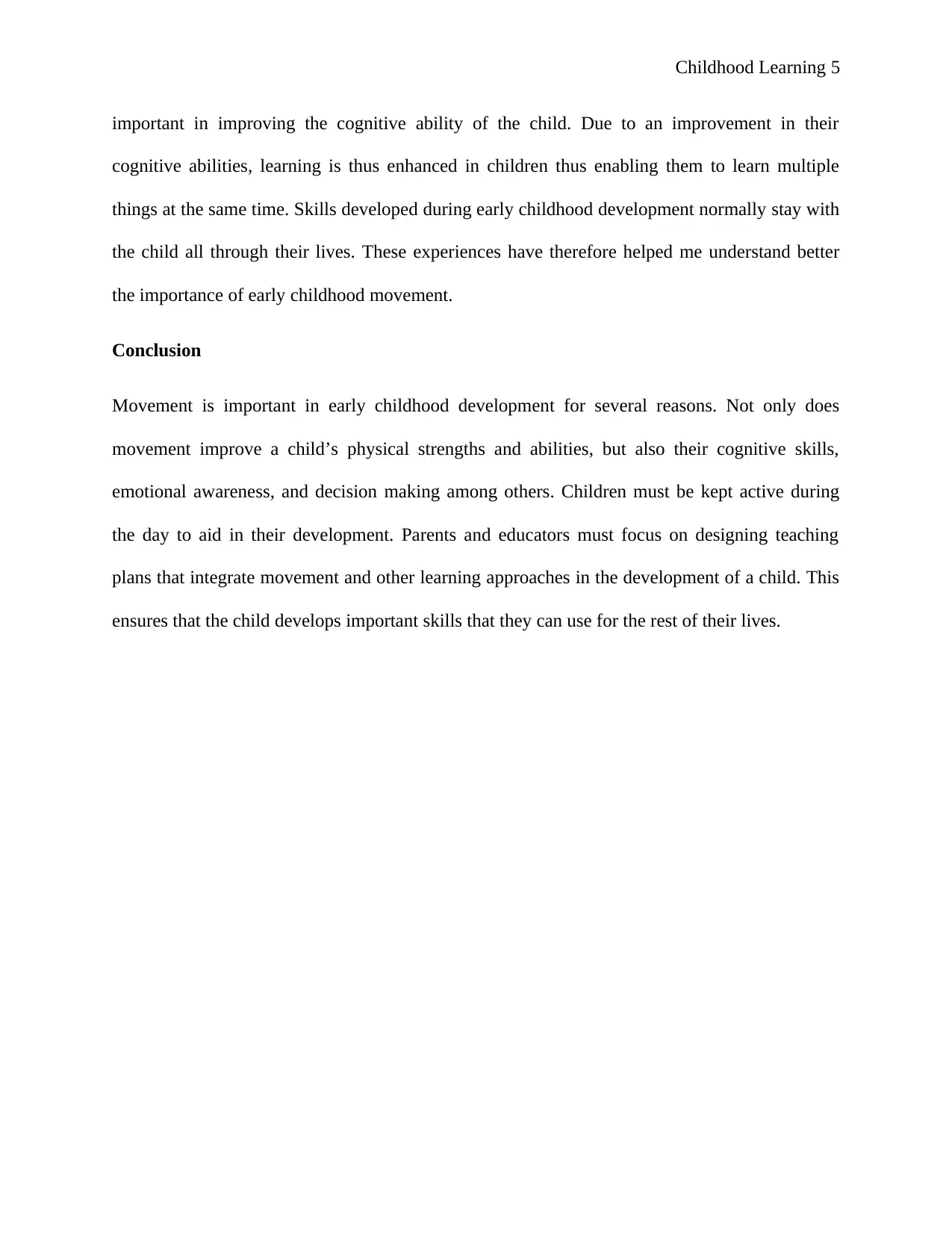
Childhood Learning 5
important in improving the cognitive ability of the child. Due to an improvement in their
cognitive abilities, learning is thus enhanced in children thus enabling them to learn multiple
things at the same time. Skills developed during early childhood development normally stay with
the child all through their lives. These experiences have therefore helped me understand better
the importance of early childhood movement.
Conclusion
Movement is important in early childhood development for several reasons. Not only does
movement improve a child’s physical strengths and abilities, but also their cognitive skills,
emotional awareness, and decision making among others. Children must be kept active during
the day to aid in their development. Parents and educators must focus on designing teaching
plans that integrate movement and other learning approaches in the development of a child. This
ensures that the child develops important skills that they can use for the rest of their lives.
important in improving the cognitive ability of the child. Due to an improvement in their
cognitive abilities, learning is thus enhanced in children thus enabling them to learn multiple
things at the same time. Skills developed during early childhood development normally stay with
the child all through their lives. These experiences have therefore helped me understand better
the importance of early childhood movement.
Conclusion
Movement is important in early childhood development for several reasons. Not only does
movement improve a child’s physical strengths and abilities, but also their cognitive skills,
emotional awareness, and decision making among others. Children must be kept active during
the day to aid in their development. Parents and educators must focus on designing teaching
plans that integrate movement and other learning approaches in the development of a child. This
ensures that the child develops important skills that they can use for the rest of their lives.
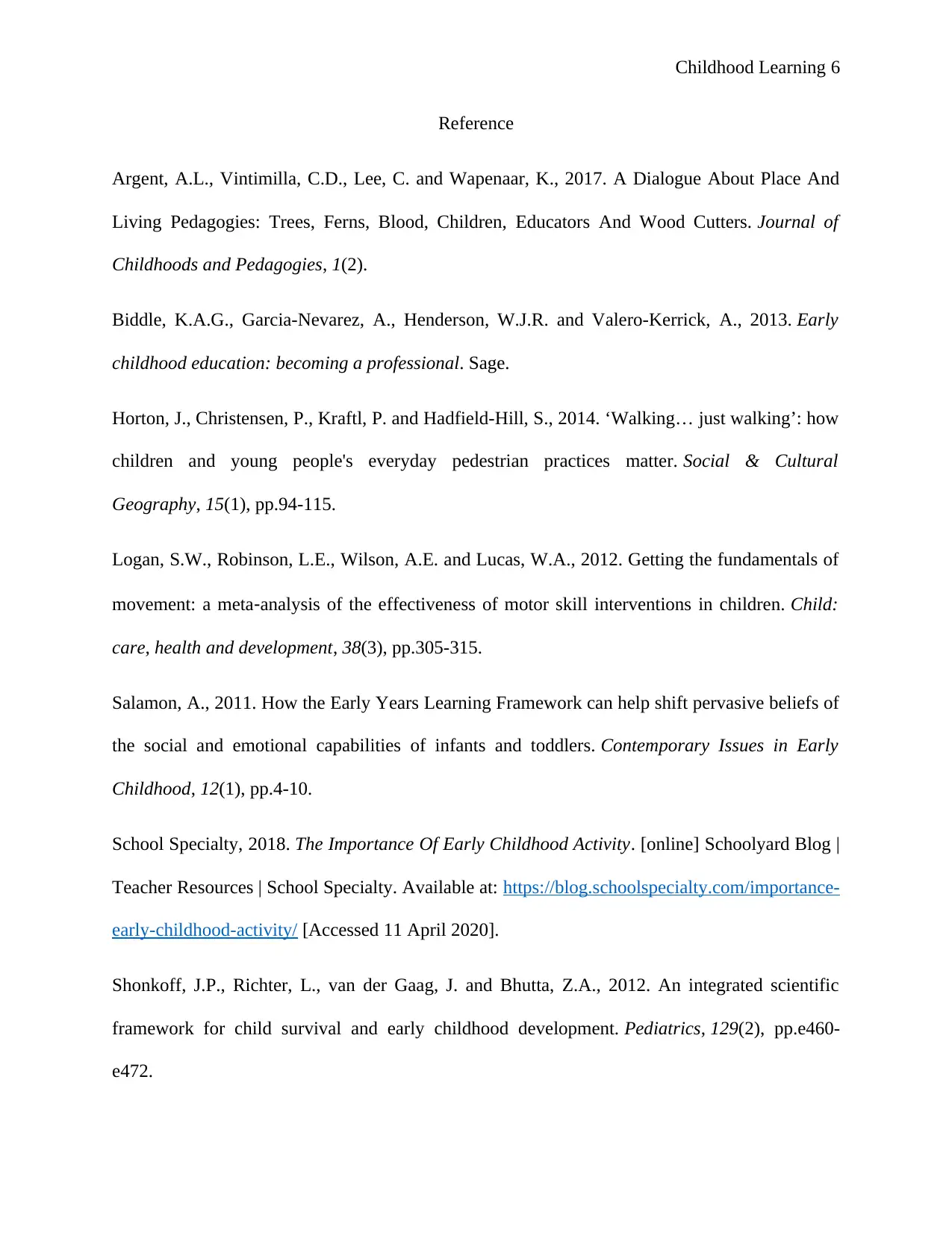
Childhood Learning 6
Reference
Argent, A.L., Vintimilla, C.D., Lee, C. and Wapenaar, K., 2017. A Dialogue About Place And
Living Pedagogies: Trees, Ferns, Blood, Children, Educators And Wood Cutters. Journal of
Childhoods and Pedagogies, 1(2).
Biddle, K.A.G., Garcia-Nevarez, A., Henderson, W.J.R. and Valero-Kerrick, A., 2013. Early
childhood education: becoming a professional. Sage.
Horton, J., Christensen, P., Kraftl, P. and Hadfield-Hill, S., 2014. ‘Walking… just walking’: how
children and young people's everyday pedestrian practices matter. Social & Cultural
Geography, 15(1), pp.94-115.
Logan, S.W., Robinson, L.E., Wilson, A.E. and Lucas, W.A., 2012. Getting the fundamentals of
movement: a meta‐analysis of the effectiveness of motor skill interventions in children. Child:
care, health and development, 38(3), pp.305-315.
Salamon, A., 2011. How the Early Years Learning Framework can help shift pervasive beliefs of
the social and emotional capabilities of infants and toddlers. Contemporary Issues in Early
Childhood, 12(1), pp.4-10.
School Specialty, 2018. The Importance Of Early Childhood Activity. [online] Schoolyard Blog |
Teacher Resources | School Specialty. Available at: https://blog.schoolspecialty.com/importance-
early-childhood-activity/ [Accessed 11 April 2020].
Shonkoff, J.P., Richter, L., van der Gaag, J. and Bhutta, Z.A., 2012. An integrated scientific
framework for child survival and early childhood development. Pediatrics, 129(2), pp.e460-
e472.
Reference
Argent, A.L., Vintimilla, C.D., Lee, C. and Wapenaar, K., 2017. A Dialogue About Place And
Living Pedagogies: Trees, Ferns, Blood, Children, Educators And Wood Cutters. Journal of
Childhoods and Pedagogies, 1(2).
Biddle, K.A.G., Garcia-Nevarez, A., Henderson, W.J.R. and Valero-Kerrick, A., 2013. Early
childhood education: becoming a professional. Sage.
Horton, J., Christensen, P., Kraftl, P. and Hadfield-Hill, S., 2014. ‘Walking… just walking’: how
children and young people's everyday pedestrian practices matter. Social & Cultural
Geography, 15(1), pp.94-115.
Logan, S.W., Robinson, L.E., Wilson, A.E. and Lucas, W.A., 2012. Getting the fundamentals of
movement: a meta‐analysis of the effectiveness of motor skill interventions in children. Child:
care, health and development, 38(3), pp.305-315.
Salamon, A., 2011. How the Early Years Learning Framework can help shift pervasive beliefs of
the social and emotional capabilities of infants and toddlers. Contemporary Issues in Early
Childhood, 12(1), pp.4-10.
School Specialty, 2018. The Importance Of Early Childhood Activity. [online] Schoolyard Blog |
Teacher Resources | School Specialty. Available at: https://blog.schoolspecialty.com/importance-
early-childhood-activity/ [Accessed 11 April 2020].
Shonkoff, J.P., Richter, L., van der Gaag, J. and Bhutta, Z.A., 2012. An integrated scientific
framework for child survival and early childhood development. Pediatrics, 129(2), pp.e460-
e472.
⊘ This is a preview!⊘
Do you want full access?
Subscribe today to unlock all pages.

Trusted by 1+ million students worldwide
1 out of 6
Related Documents
Your All-in-One AI-Powered Toolkit for Academic Success.
+13062052269
info@desklib.com
Available 24*7 on WhatsApp / Email
![[object Object]](/_next/static/media/star-bottom.7253800d.svg)
Unlock your academic potential
Copyright © 2020–2025 A2Z Services. All Rights Reserved. Developed and managed by ZUCOL.




